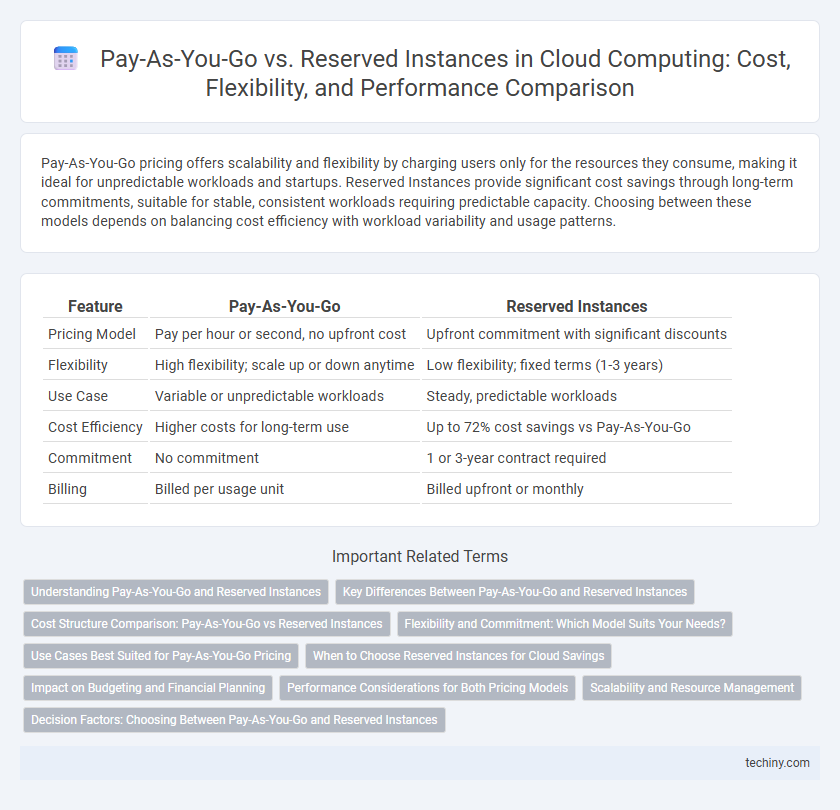Pay-As-You-Go pricing offers scalability and flexibility by charging users only for the resources they consume, making it ideal for unpredictable workloads and startups. Reserved Instances provide significant cost savings through long-term commitments, suitable for stable, consistent workloads requiring predictable capacity. Choosing between these models depends on balancing cost efficiency with workload variability and usage patterns.
Table of Comparison
| Feature | Pay-As-You-Go | Reserved Instances |
|---|---|---|
| Pricing Model | Pay per hour or second, no upfront cost | Upfront commitment with significant discounts |
| Flexibility | High flexibility; scale up or down anytime | Low flexibility; fixed terms (1-3 years) |
| Use Case | Variable or unpredictable workloads | Steady, predictable workloads |
| Cost Efficiency | Higher costs for long-term use | Up to 72% cost savings vs Pay-As-You-Go |
| Commitment | No commitment | 1 or 3-year contract required |
| Billing | Billed per usage unit | Billed upfront or monthly |
Understanding Pay-As-You-Go and Reserved Instances
Pay-As-You-Go pricing in cloud computing charges users based on actual resource consumption, offering flexibility and scalability without upfront commitments. Reserved Instances require a long-term commitment, often one to three years, providing significant cost savings in exchange for guaranteed resource availability. Choosing between these models depends on workload predictability and budget considerations, with Pay-As-You-Go suited for variable usage and Reserved Instances optimized for steady, predictable workloads.
Key Differences Between Pay-As-You-Go and Reserved Instances
Pay-As-You-Go pricing offers flexible, usage-based billing without upfront commitments, ideal for variable workloads and unpredictable demand. Reserved Instances require upfront payment for a specific term, typically one or three years, providing significant cost savings and capacity reservation for steady-state applications. Key differences include cost predictability, commitment level, and suitability for either fluctuating or consistent cloud resource needs.
Cost Structure Comparison: Pay-As-You-Go vs Reserved Instances
Pay-As-You-Go pricing in cloud computing offers flexible, usage-based billing ideal for variable workloads, with costs calculated per hour or second, minimizing upfront expenses. Reserved Instances require upfront commitment for one or three years, providing significant discounts--up to 75%--compared to Pay-As-You-Go rates, optimizing costs for steady-state and predictable usage. Evaluating workload patterns and financial flexibility ensures the optimal cost structure between on-demand elasticity and reserved capacity savings.
Flexibility and Commitment: Which Model Suits Your Needs?
Pay-As-You-Go cloud computing offers maximum flexibility by allowing users to scale resources instantly without long-term commitments, ideal for variable workloads and startups. Reserved Instances require upfront commitment but provide significant cost savings for predictable, steady-state applications, making them suitable for enterprises with stable demand. Evaluating workload patterns and budget priorities helps determine whether the agility of Pay-As-You-Go or the cost efficiency of Reserved Instances aligns better with your cloud strategy.
Use Cases Best Suited for Pay-As-You-Go Pricing
Pay-As-You-Go pricing is ideal for startups and businesses with unpredictable workloads, enabling cost efficiency by paying only for actual resource consumption. It suits development and testing environments where usage varies frequently, eliminating the need for long-term commitments. Organizations scaling rapidly or running seasonal applications benefit from the flexibility and immediate resource availability offered by Pay-As-You-Go models.
When to Choose Reserved Instances for Cloud Savings
Reserved Instances offer significant cost savings for predictable, steady-state workloads by allowing users to commit to long-term usage with discounted hourly rates compared to Pay-As-You-Go pricing. Enterprises with consistent resource demands, such as web hosting, databases, or backend services running 24/7, benefit the most from Reserved Instances due to their ability to lower total cost of ownership. Selecting Reserved Instances is ideal when capacity planning is reliable and the organization aims to optimize cloud expenditure with upfront or partial upfront payment models.
Impact on Budgeting and Financial Planning
Pay-As-You-Go pricing in cloud computing offers flexibility with costs directly tied to actual usage, enabling precise short-term budgeting but potentially causing unpredictable monthly expenses. Reserved Instances require upfront commitment for a fixed term, significantly reducing hourly rates and offering more predictable, stable budgeting ideal for long-term financial planning. Businesses balancing immediate scalability and long-term cost efficiency must evaluate workload patterns and financial goals to choose between variable spending and guaranteed savings.
Performance Considerations for Both Pricing Models
Pay-As-You-Go pricing in cloud computing offers flexibility with on-demand resource allocation, ensuring consistent performance for variable workloads without upfront commitments. Reserved Instances provide cost savings through long-term capacity reservation, often resulting in optimized performance for steady-state applications by guaranteeing resource availability. Performance in Pay-As-You-Go may vary during peak times due to shared infrastructure, while Reserved Instances deliver predictable throughput by dedicating virtual capacity.
Scalability and Resource Management
Pay-As-You-Go pricing offers unmatched scalability by allowing businesses to instantly adjust cloud resources based on fluctuating demand, eliminating upfront commitments and minimizing idle capacity costs. Reserved Instances provide cost efficiency for predictable workloads with reserved capacity at discounted rates but limit flexibility when scaling beyond the reserved amount. Effective resource management balances Pay-As-You-Go's dynamic scaling benefits with Reserved Instances' cost savings to optimize cloud infrastructure performance and budget control.
Decision Factors: Choosing Between Pay-As-You-Go and Reserved Instances
Choosing between Pay-As-You-Go and Reserved Instances depends primarily on workload predictability, budget constraints, and long-term commitment plans. Pay-As-You-Go offers flexibility for variable or unpredictable usage patterns with no upfront costs, while Reserved Instances provide significant cost savings for steady, predictable workloads through upfront payment commitments. Evaluating usage consistency, forecasted resource demand, and financial flexibility helps optimize cloud computing expenses and resource management.
Pay-As-You-Go vs Reserved Instances Infographic

 techiny.com
techiny.com